Holy Passion Processions in Panjim
At the Church of the Immaculate Conception – the Igreja Matriz or main parish church of Panjim – the sixth Sunday of Lent begins on a festive note. It is Palm Sunday, which commemorates the triumphant entry of Jesus in Jerusalem.
However, after the morning Masses, there is a visible change in the mood, especially with the unveiling of the tableau in the chancel: a larger-than life-size statue of Christ carrying the Cross. Hence, the day's alternative designation: Passion Sunday.
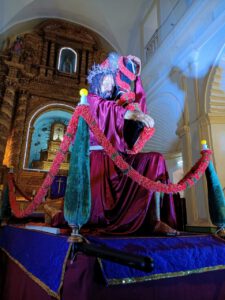
The evening of Passion Sunday features a solemn procession that begins from and ends at the iconic church. It is the highpoint of the Santos Passos (‘Holy Steps’) held on the first five Sundays of Lent, highlighting some of the most intense moments of Christ’s Passion leading to Calvary: the Agony in the Garden of Gethsemane; the Arrest of Jesus; the Flagellation at the Pillar; the Crowning with Thorns; the condemnation by Pontius Pilate (See my blogpost https://www.oscardenoronha.com/2019/03/17/santos-passos-in-panjim/ ). Other churches in Goa do not necessarily have the same set-ups (See https://www.oscardenoronha.com/2021/03/21/lenten-traditions-in-goa/ ).
Passion Sunday signals the beginning of the Holy Week. The predominant colour is purple; the altars are bare and there is not a flower arrangement to be seen. After the evening Mass, a procession called Cruz às costas – the same tableau of Jesus carrying the Cross – wends its way through some of the main thoroughfares of the capital city: the Church square, a section of 18 June, Pissurlencar, past Azad Maidan.

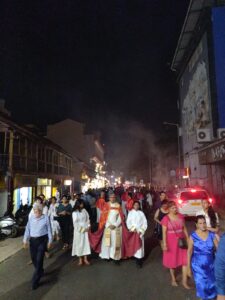
Confrades (Church confraternity members) wearing opa e murça (a red and white cape) carry the statue concertedly, giving the impression that it is floating on its own power. In the past, a brass band would follow; but nowadays, a choir sings from an intermediate landing of the church's zigzag stairway. The singing and prayers are heard throughout the route via funnel loudspeakers. The procession is animated by the recitation of five Sorrowful Mysteries of the Rosary until the end of the procession.
The circuit is marked by over ten descansos (halts), at which points the faithful flock to kiss the statue. A major halt happens at the Capela da Conceição (Chapel of the Immaculate Conception). Built in 1823, it was once a private chapel attached to the mansion of Dom Lourenço de Noronha, scion of a Portuguese noble family, and was later bequeathed to the Confrarias of Panjim church and has been under repairs since 2019.
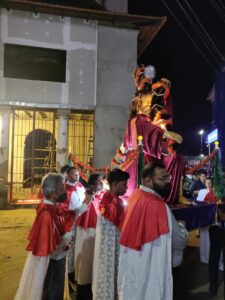

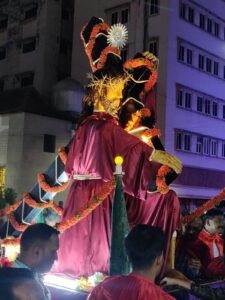
The cavalcade then proceeds via M. G. Road and Dr D. R. de Sousa, past the Garcia de Orta Garden, and up to the church square. Here, at the foot of the stairway, Jesus is met by His Blessed Mother. Sorrowing over her Son so unjustly accused and made to carry the Cross to His death, she accompanies him on his last last legs, as she did two thousand years ago to Golgotha.
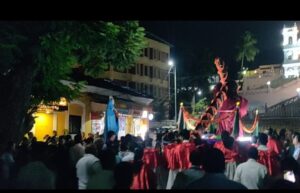
Soon thereafter, the two statues halt on the intermediate landing in front of a large cross carved out of the wall. A level higher, from a pulpit-like balcony jutting out of the said wall, a little girl unrolls the Veil of Veronica while she sings the traditional narrative. This is about the meeting of the legendary woman (feast day, 12 July) with Jesus. As recorded in the fourth station of the Via Crucis (Way of the Cross), Veronica, moved by the sight of Jesus carrying the Cross, wiped his brow with her handkerchief only to find a lasting imprint of his holy face on the cloth.
Thus ends Passion Sunday and preparations begin for the Holy Triduum beginning on the evening of Maundy Thursday. This day, which comprises a Mass with the reenactment of the historic Washing of the Feet by Jesus, marks the institution of the Eucharist and the Priesthood and the proclamation of the Commandment of Love. There is no public procession.
Five days later, on Good Friday, the processional arrangement is the same as on Passion Sunday, except for a few obvious differences.
The poignant Crucifixion tableau opens in the chancel at 3 o’clock in the afternoon. It is interesting how by then the sky is usually cloudy and the mood sombre. The liturgy of the Word and the Eucharist continue until at about half past five. Then, a procession of a larger-than-life-size statue of Senhor Morto (The Departed Lord) placed on an andor (black canopied wooden platform) starts off, with the statue of Our Lady in trail.
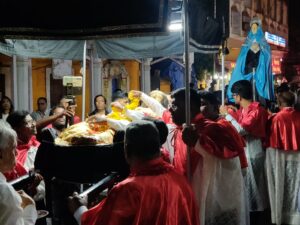
There are some other differences too. Today, the faithful are in funereal attire, which once upon a time was de rigueur. And instead of the sanctus bell, we hear the matraca or wooden rattle at every halt in the procession.
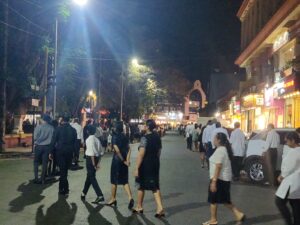
A major difference between the Passion Sunday and the Good Friday procession lies at their very end. This time round, in a coda to the baroque event, is the Sermão da Soledade de Maria (Sermon on the Solitude of Mary) delivered by a priest from the same pulpit-like balcony. The preacher extols the virtues of Mary and highlights her present solitude. Formerly, rhetoric played a crucial role on such occasions, helping to fully engage the congregation. Nowadays, the limited number of faithful who stay on to listen are easily distracted, not least by vehicle noises that detract from the solemn ambience.
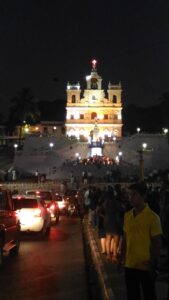
In this context, one striking similarity between the processions is that both are watched in awe by people of other religions. On both occasions, residences put up decorative lights, candles or oil lamps in homage to Our Lord. Some non-Christian establishments remain open, it being a weekday, do the same. People from other religions watch in awe, including policemen (one of whom I saw standing at attention and saluting the Departed Lord). Particularly interesting is the case of the Caculos and the Neurencars, two Hindu families on Pissurlencar Street; they traditionally offer garlands of xenvtim or abolim.
Depending on the number of attendees, the pious, kilometre-long march and related ceremonies on both days take between 75 and 90 minutes. The statues return to the church for concluding rites and veneration. By 8 o’clock, they call it a night!
Behold two processional events in Panjim that have left a lasting imprint on my mind. So was it when my life began; so is it now I am a man. So be it when I grow old – for this ancient tradition is without a doubt one of the most moving spectacles in the religious and cultural calendar of my city, Panjim.
Requests:
1- In the comments section below, do share snippets of similar traditions in your village or city, and document them whenever possible.
2 - Do watch my video titled "Passion Sunday Procession in Panjim", on http://www.youtube.com/@oscardenoronha
Good Friday Procession in Panjim
The 3 o’clock, Good Friday service at the city church of the Immaculate Conception comprises a poignant Crucifixion tableau.
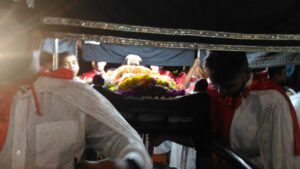
Soon thereafter, a procession of Senhor Morto (Dead Lord) on an andor (black canopied wooden platform carrying a life-size statue of Our Lord who died on the Cross) starts off, with a statue of Our Lady in trail. It wends its way through the main thoroughfares (the church square, a section of 18th June, Pissurlencar, past Azad Maidan), making a major halt to pray at the chapel formerly attached to the mansion of a Portuguese noble family. The cavalcade then proceeds via M. G. Road and Dr D. R. de Sousa, past the Garcia de Orta Garden, and up the church stairway.

The pious march takes approximately 90 minutes. It is animated by five decades of the Marian rosary recited over speakers fitted at several points; and by Lenten hymns sung by a choir to the accompaniment of a brass band. The circuit is marked by over ten descansos (halts). At these points, penitents, all of them de rigueur, in funereal attire, flock to the two statues. Members of other religious faiths also pay their respects; many watch in awe or stand at attention (I noticed a policeman saluting).
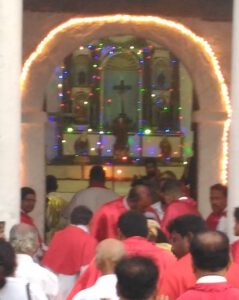
One such halt is at a quaint chapel traditionally called 'Capela de Dom Lourenço', located behind what is now the iconic Hotel Mandovi. In times past, the chapel was part of the manor belonging to Dom Lourenço de Noronha, a Portuguese nobleman, who had acquired a large estate in the then incipient city centre. After the palatial mansion was razed, the chapel was handed over to the care and possession of the city church. Alas, the venerable structure is in a state of disrepair.
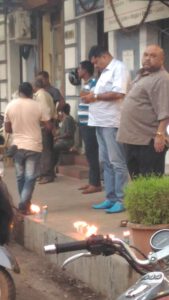
On the said route, two Hindu families (Caculó and Neurencar) traditionally offer garlands. Businesses brighten up their establishments, or simply light candles and burn incense on the adjoining pavements.
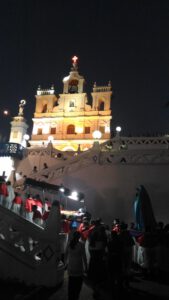
In a coda to the baroque event is a sermon (Sermão da Soledade de Maria) at a stair landing: here, from a balcony that serves as a makeshift pulpit, a priest extols the virtues of Mary and highlights her present solitude. The congregation listens in silence even while vehicle noises spoil the ambience.
The statues return to the church for final veneration. By 8 o’clock, they call it a night!
Lent, an irresistible balm for the soul
Haven’t we felt listless, not to say ill at ease, about Lent, sometime in our life? As a child, I tagged along with my parents to liturgical services that made little sense. Not surprisingly, on reaching the age of reason, I had to be cajoled into attending them. Then, suddenly, I got a break. I found motets, songs for the season, composed by Goa’s unnamed musicians of old, to be an absolute feast for the ears, alongside similar compositions by Bach, Palestrina and Mozart. I also discovered, quite ironically, that the Via Dolorosa in the balmy evening breeze and to the chirping of birds in the woods of Altinho was not so dolorous after all!
Much as I delighted in those two little secrets, at one point I felt an interior dryness, a sense of futility, as though I were trudging a wasteland. The saving grace came from my grandmother’s exemplary life, which was far better than precept. Likewise, my parents’ quiet commitment to the Faith, amidst their daily toil and moil, provided important insights into the valley of tears we live in. And Scripture wrapped it up so beautifully: “Look at the birds of the air: they neither sow nor reap nor gather into barns, and yet your heavenly Father feeds them. Are you not of more value than they?” (Mt. 6: 26)
Clearly, the rituals that I had cheekily dismissed yesterday changed into victuals for the spirit today. And as another season of Lent comes round, I know just how it will turn out, how they will sustain me…. Beginning Ash Wednesday, I will go to church more often than usual, for Mass and Stations of the Cross. On a hopefully bright and festive Palm Sunday morning, I will feel cheery. Yet, by evening, my mood will change hugely – as it always did when I witnessed the spectacle of the full-size statue of the Suffering Lord emerge from the immaculately white church of the zigzag stairway, to join the faithful clad in dark shades, in a penitential procession through the streets of the capital.
What a poignant start to the Holy Week! It’s the last lap of an all-embracing spiritual journey. You’ll probably catch me shaking off distractions on holy Monday, Tuesday and Wednesday. Through the rest of the week, I will be all eyes and ears to the Mystery of mysteries replayed in the Paschal Triduum, from the moment of that bittersweet Last Supper on Maundy Thursday through excruciating Good Friday and triumphant Easter Sunday. Soon, the week’s darkness will give way to light and its drabness will translate into loud proclamations. The faithful will be beside themselves, singing in an unending refrain: “No one can give to me that peace that my Risen Lord, my Risen King can give.”
It pays to be fools for Christ; Chesterton’s “Donkey” is proof that there will be no regrets. The thought of self-privation, which had bugged me when young, doesn’t assail me. I find it easier now to give up a favourite food or a much-loved pastime. Penance and sacrifice, besides fostering self-discipline and tempering our desires, are game-changers. They help to boost one’s spiritual life and improve our physical health. We are led to find ways and means to step up our knowledge of our faith; perform acts of kindness and mercy, wherever we may be; pray for others, and clean ourselves inside out by means of a holy confession. Before long, we learn to slow down, while the rest of the world is in a rat race, enjoying in a fool’s paradise.
It is reassuring to think of Lent as pilgrimage toward the profound mystery of the passion, death and resurrection of Jesus Christ. Benedict XVI says it is also “a privileged time of interior pilgrimage toward Him who is the fount of mercy. It is a pilgrimage in which He himself accompanies us through the desert of our poverty, sustaining us on our way toward the intense joy of Easter.” How, then, can we be listless or ill at ease at Lent when an irresistible balm for our soul is at hand?
(First published in The Times of India, Panjim, 1 March 2017)


